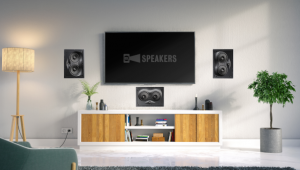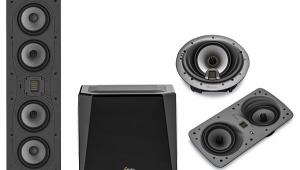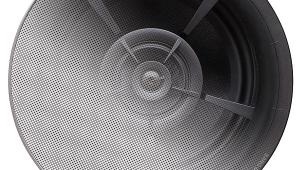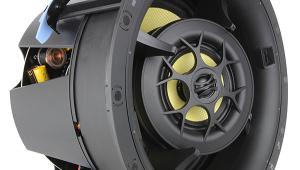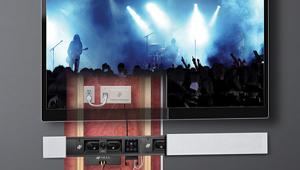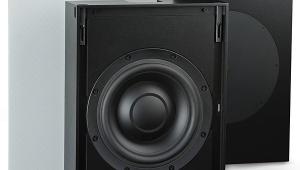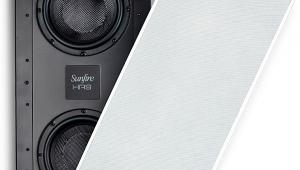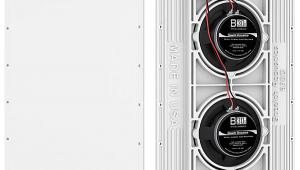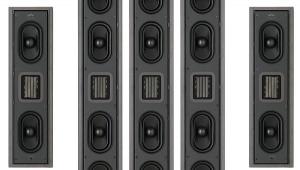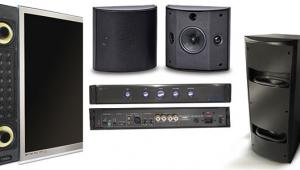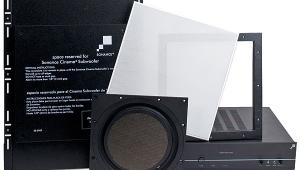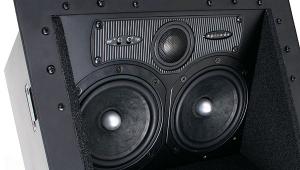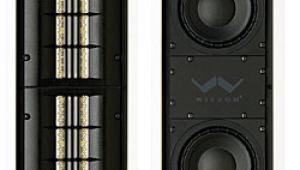Sonance VP89 In-Wall Speaker System
According to industry legend, Sonance got its start in the in-wall speaker business by installing a cabinet speaker in a wall and covering it with a custom grille. The customer was so pleased with the results that the founders of the company decided to design a true in-wall speaker, believing that others would want them too. As they say, the rest is history.
 Today, Sonance manufactures a wide selection of in-wall and
in-ceiling speakers, electronics, and accessories for the custom home theater industry and for professional venues. Although the company is certainly not alone in the in-wall speaker category, it’s hard not to mention Sonance when discussing in-wall speakers.
Today, Sonance manufactures a wide selection of in-wall and
in-ceiling speakers, electronics, and accessories for the custom home theater industry and for professional venues. Although the company is certainly not alone in the in-wall speaker category, it’s hard not to mention Sonance when discussing in-wall speakers.
Visual Performance Series
The Visual Performance series is one of Sonance’s newest lines of in-wall speakers. They’re designed for the homeowner who wants in-wall speakers that can be heard but not necessarily seen. Their clean, sleek appearance doesn’t scream “speaker” and they are designed to integrate discreetly into a living space. The speakers’ nearly flush profile extends just slightly beyond the wall surface, and the micro-flange grilles reveal only 0.2 inches of trim. You can paint the grilles in one step, as opposed to a conventional in-wall speaker, where you have to paint the flange and grille separately. The grille attaches to the speaker baffle with very strong magnets positioned around the perimeter of the grille and baffle. Simply waving the grille near the speaker and releasing it places it easily and squarely. The magnets do the rest. The VP89 is the flagship of the Visual Performance series, succeeding the VP87 and VP85. Those previous models use coated and uncoated carbon-fiber cone materials as well as silk and aluminum domes, respectively, compared with the VP89’s beryllium cones and domes.
VP89 Features and Technology
The VP89 is a three-way rectangular in-wall speaker with an 8-inch woofer that incorporates a rubber surround, a 4-inch midrange driver with rubber surround, and a 1-inch tweeter with ferrofluid cooling. The woofer’s pole piece (the center portion of the magnetic structure) extends beyond the apex of the cone to form a phase plug, whose main mission is to produce smoother response at the upper end of the woofer’s range, among others. The midrange and tweeter are concentrically aligned and can pivot to direct sound into the listening area. Each has a separate three-position level control marked with a range of +3/–3 decibels.
All three drivers in the VP89 employ beryllium diaphragms. Beryllium is a relatively rare element with some unusual properties. It’s used extensively in aerospace, communications satellites, aircraft brakes, space telescopes, and other high-tech applications because of its high strength and hardness. Its value in loudspeaker cones is its lower density and higher rigidity when formed into a speaker cone. Beryllium is used as an alternative to titanium and aluminum. Lower-density materials have less mass and are lighter, making them easier to stop and start, which may contribute to improved transient response. Higher rigidity allows less flexing of the cone and thus reduces mechanical distortion, especially at high volumes.
The drivers are mounted on a ribbed baffle, which is designed to break up near-field diffraction. The baffle also features a removable plug for installing an infrared receiver. An IR receiver can pass control signals to electronics installed in a hidden location.
The VP89 speakers are biwire or biamp capable, but Sonance ships them with jumper wires that connect the gold-plated speaker terminals for single-wire connection. The speaker terminals attach to a plate that covers the crossover on the back of the speaker. To configure the speakers for biwiring or biamping, you must remove the plate, remove the jumper wires, and re-install the plate.
An in-wall speaker’s performance depends heavily on the cavity volume and rigidity of the wall in which it is installed. A floorstanding or in-room speaker is tuned for its enclosure, but in-wall speakers generally are not. As a result, sound performance can vary between installations. A common solution is to provide a back box or enclosure for the speaker, which produces a more consistent sound quality regardless of the overall cavity volume or wall construction.
Sonance offers two optional acoustic enclosures for the VP89, one for retrofit installations and another for new construction. The retrofit enclosure is made of glass-reinforced polypropylene. The volume is relatively small to accommodate existing construction, so the speaker’s low-frequency response rolls off rapidly below 80 hertz. Sonance recommends this option to provide sound containment between rooms in existing construction.
The second option, an enclosure for new construction, is made from 0.5-inch medium density fiberboard (MDF). Sonance considers this option superior because the enclosure’s larger internal volume is optimized for the 8-inch woofer. As a result, the speaker’s low-frequency response is better.
Installation
I tested the Sonance VP89 speakers in portable bays I built for testing in-wall speakers. The testing bays use typical residential wall construction with 16-inch on-center stud spacing and 0.5-inch drywall. The cavity is filled with R-30 insulation. Each bay sits on a base and can be moved around the room for stereo and multichannel testing. In this review, I tested five VP89s in bays with a subwoofer for a 5.1-channel system.
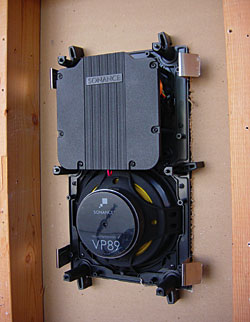 The Sonance VP89 speakers attach to the wall using Roto-Lock clamps. These are conventional dogleg devices that automatically rotate into position and secure the speaker to the wall when tightened. About the only thing better than an assistant or a third hand to hold the speaker in place are Sonance’s FastMount tabs. The tabs are metal clips that temporarily hold the speaker in the wall cutout while you or your installer reach for a screwdriver to tighten the Roto-Lock clamps or attach speaker wires. Without the FastMount tabs, the speaker simply falls out of the wall cutout onto the floor. If it becomes necessary to remove the speaker, the FastMount tabs release and fall behind the wall, allowing easy removal of the speaker.
The Sonance VP89 speakers attach to the wall using Roto-Lock clamps. These are conventional dogleg devices that automatically rotate into position and secure the speaker to the wall when tightened. About the only thing better than an assistant or a third hand to hold the speaker in place are Sonance’s FastMount tabs. The tabs are metal clips that temporarily hold the speaker in the wall cutout while you or your installer reach for a screwdriver to tighten the Roto-Lock clamps or attach speaker wires. Without the FastMount tabs, the speaker simply falls out of the wall cutout onto the floor. If it becomes necessary to remove the speaker, the FastMount tabs release and fall behind the wall, allowing easy removal of the speaker.
A frustrating thing with the VP89s is that the four speaker terminals (two for mid-high frequencies and two for low frequencies) are labeled only on the inside of the plate, making them difficult to see. You’ll have to either remove the plate or, as I did, use a mirror to see behind the plate. Also, the printed instructions are not clear. Perhaps Sonance expects experienced installers, not homeowners, to install the speakers. Sonance said it plans to update the instructions in future printings.
Listening Tests
I tested the VP89s using various stereo and multichannel music sources that I’m familiar with and use frequently for testing speakers and components. I also used movies encoded in Dolby Digital 5.1 and DTS.
The VP89 has a taut, snappy sound quality that is most notable in the midrange and high frequencies. It doesn’t have the harsh or strident sound characteristic often attributed to metallic drivers. Rather, it’s a trait that satisfyingly reproduces many musical instruments, particularly string and percussion instruments. The mandolin, fiddle, and guitar in Nickel Creek’s “The Lighthouse’s Tale” and “Out of the Woods” (Nickel Creek, Sugar Hill Records) sound faithful to the acoustic instruments that this bluegrass trio plays. They sounded the way you would expect them to sound. In particular, mandolin and guitar strings should have a sharp, quick attack when plucked or strummed, and the VP89’s low-mass beryllium drivers reproduce this very well. The speakers sounded best to my ear with the midrange and tweeter level controls set in the neutral position.
I heard the same transient attributes in the sound of the typewriter in Atonement (DVD, Universal), a tragic story set in England around the start of World War II. An old Corona typewriter provides a transitional sound effect between story lines. With the Sonance speakers, it sounds exactly like an antique typewriter, with the swift, sudden snap of a metal key striking a piece of paper. It’s a subtle detail, but it contributes to the true-to-life sound that listeners expect. It’s the kind of thing that makes a good movie soundtrack realistic and enjoyable.
Music also plays a key role in telling the story of Atonement, and here the Sonance VP89s didn’t disappoint. Stirring music and an a cappella group of soldiers singing hymns accompany the moving scenes on the beach at Dunkirk. The camera moves across the thousands of soldiers on the beach, some severely injured, awaiting evacuation the following day. As the camera moves across the beach, the sonic perspective of the singers changes to reflect their position relative to the viewer. This may read more like a movie review than a speaker review, but the Sonance VP89s created a realistic, enveloping soundfield that brought this depressing scene to life.
The VP89s have good midbass performance. But regardless of their rated 30-Hz low-frequency response (+/–3 dB), they require a subwoofer to reach the lowest lows found in music and movies. The 8-inch beryllium woofers have a taut, punchy sound quality. With the crossover set at 80 Hz, they integrate easily with a subwoofer and present a balanced overall tone quality.
Summary and Conclusions
Many years have passed since Sonance installed that cabinet speaker in a wall and launched the in-wall speaker category. The VP89 is a clear example of how much in-walls have improved and is sure to please both casual and critical listeners alike. Its crisp, clean, and detailed sound is easy to listen to with music and movie sources, especially when combined with a subwoofer. The speakers are easy to install, they make a nice complement to any room décor, and they’re reasonably priced at $2,700 per pair. I would highly recommend including one of Sonance’s acoustic enclosures with the installation of the VP89s because they eliminate the wall cavity as a variable factor in performance.
Sonance’s Visual Performance series speakers are a good choice for a multiroom audio system or as a complement to a flat-panel television. In addition to the VP89, the Visual Performance series speakers are available in rectangular, square, and round models for in-wall and in-ceiling installations.
Highlights
Roto-Lock clamps and FastMount tabs make installation a breeze
Emotionally moving reproduction of music and movie soundtracks
Optional back boxes are available
- Log in or register to post comments
